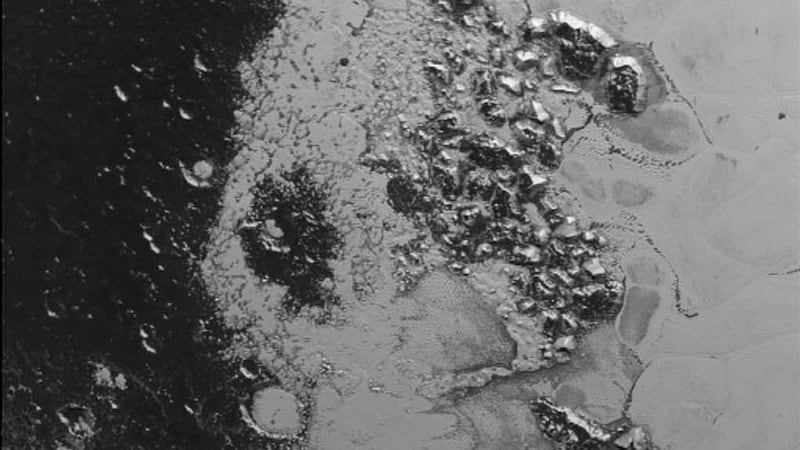New photos of Pluto released by Nasa reveal flows of nitrogen ice filling up craters, an atmosphere that could be on the verge of collapse, and a mysterious reddish haze extending 100 miles above the surface.
Scientists of the space agency's historic New Horizons mission on Friday announced the discoveries with visible delight, with lead investigator Alan Stern declaring the Pluto system a "scientific wonderland".
In a new set of high-resolution images of the dwarf planet’s surface, Stern and researcher Bill McKinnon showed evidence of nitrogen moving and spreading through a vast plain near the edge of Pluto’s large, heart-shaped region.


Mr McKinnon pointed out “a pattern that indicates the flow of viscous ice” that appears to move “just like glacial flow on the Earth”. While water ice on Pluto freezes to the point of immovable bedrock, nitrogen and methane ice are “soft and malleable”, he said.
Swirling lines show what appears to be a world of icy movement: old craters breached and filling up with ice, mountains encrusted on the ages by the flows, and movements of ice around “what look to be barrier islands”, in Mr McKinnon’s words.
The spacecraft’s flight past Pluto – the first time humanity has ever inspected the former planet at close range – also provided new photos from behind the dwarf planet, and revealed a haze layer in its atmosphere that astounded the scientists.
Mr McKinnon said the team’s leading theory for the formation of the plains and flows of ice is “heat leaking out of the interior of Pluto” – an internal energy driving change on its surface. He said that there may be an internal ocean, for example, emitting heat from below the surface and nitrogen ice.
Researcher Mike Summers said the image, which shows a band of sunlight dissolving into a faint haze around Pluto, has forced scientists to "basically start from scratch" in how they think about Pluto's atmosphere.
“This is the image that almost brought tears to the eyes of the atmospheric scientists,” Mr Summers said, happy to have unexpected puzzles.
The haze of small particles extends to at least 100 miles above the surface, he said, five times higher than models had predicted and a profound mystery for the time being.
Mr Summers said that the team believes the particles in this haze are responsible for Pluto’s reddish hue – that they convert into tholins, a term that encompasses a wide range of substances that have been irradiated or lost their hydrogen. The tholins however are just one piece of the puzzle, he said, “but we do know that these substances are around and the reddish color is fairly distinctive.”
Researcher Cathy Olkin said Pluto's diverse regions and colourings could in part be explained by its long and eccentric orbit: a Plutonian year around the sun takes 248 Earth years, and its north pole is tilted to a 120-degree angle.
“Some parts are kind of baked” by sunlight, Ms Olkin said, while others receive the tholin haze “rain” or higher or lower concentrations of methane and nitrogen, likely due to seasons.
‘The beating heart of Pluto’
Stern noted that the two lobes of Pluto’s heart-shaped region are distinct, likely affected by the movement of nitrogen snow, perhaps by wind or sublimation.
MrMcKinnon suggested that the heart could be “a supply zone” or “reservoir” for the atmosphere and geological activity on the planet.
“We describe this poetically as the beating heart of Pluto,” he said.
Mr McKinnon also showed off a new ice mountain range, named Hillary Montes after Mt Everest pioneer Sir Edmund Hillary, and "the very ancient, heavily cratered region informally called Cthulhu", after HP Lovecraft's fictional monster god.
In this southern region, flows of ice “seem to have moved and surrounded and embayed” the mountains, he said, forming “a lot of fine structure” that differs from elsewhere on the dwarf planet.
New Horizons may have also reached Pluto at a stage right before its atmosphere freezes up or vanishes entirely. Early data shows that Pluto’s atmosphere has decreased by a factor of two in about two years – an “astonishing” rate to shrink, Mr Summers said.
Stern added that some models had suggested that Pluto is on the verge of atmospheric collapse, and if that were the case then the mission had arrived just in time. “It would be an amazing coincidence,” he said, “but there would be some on our team that would say ‘I told you so.’”
Stern and his fellow investigators also announced that they had found a massive and uniquely dense concentration of carbon monoxide in the smooth, heart-shaped region spanning a wide swath of Pluto’s face.
The new results follow a thrilling two weeks for the team, as researchers have received huge amounts of data from New Horizons’ fly-by past Pluto, after a journey nine years and 3bn miles in the making.
On the 14th of July, New Horizons flew within 7,700 miles of Pluto’s surface, a fly-by that made the US the only nation to have visited every planet in the classical solar system.
Last week Nasa revealed high-resolution images of Pluto’s frozen plains and hillocks, a region that abuts 11,00ft ice mountains and was described by one scientist as “hard-to-explain terrain”.
Without craters and threaded with strange troughs and trenches, the images suggested that Pluto remains very geologically active. The absence of craters likely means the plains and nearby mountain range could be only 100m years old, younger than the Himalayas on Earth and extraordinarily new compared to the 4.6bn years of the solar system.
Powered by decaying plutonium, New Horizons is now more than 7m miles past Pluto, and could continue to explore the Kuiper Belt and beyond for another two decades. Stern said that the team has only downloaded about 5% of the data collected by the spacecraft.
The space agency announced on Thursday that its Kepler mission has found an “Earth 2.0” , the ex-planet closest to our world’s size, orbit and sun yet discovered.
Guardian









